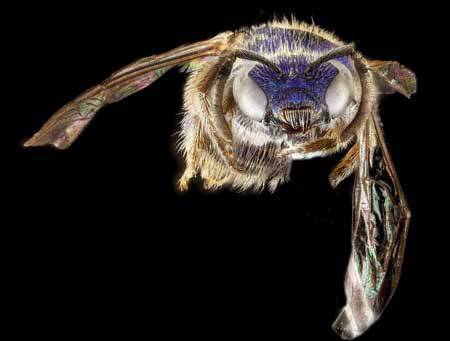Can We Save Bees by Using Them to Deliver Natural Pesticides?

Pest control agent on the wing? (Photo: Sam Droege/USDA)
One of the most persistent and destructive problems in modern agriculture is its heavy reliance on pesticides. The United States alone uses about 1.1 billion pounds of these chemicals every year to protect flowering crops. The indiscriminate spraying doesn’t just pollute soil and water, it also kills many of the beneficial organisms those same flowering crops depend on. That’s in addition to contamination of fruits and vegetables: residues of 165 different pesticides turned up in a 2013 U.S. Department of Agriculture sampling of the foods we eat every day.
But what if, instead of crop-dusters blanketing fields with chemicals, you could use bees to deliver a precise dose of a treatment directly to the plants that need them? That is, what if you could piggyback on the vital work pollinating insects are already performing, instead of inadvertently killing them?
That’s the idea in the technology called “entomovectoring.” Researchers in Canada and Europe have been experimenting for years with the idea of using bees (the “entomological” part of that word) as delivery systems (or vectors). They equip commercial beehives with trays containing a powder, and when bees are leaving the hive, they tramp through the powder and carry it on their limbs the way they carry pollen. When dosed with the appropriate bacterial, viral, or fungal additives, that powder deposited on the flower can protect a plant from a particular pest or disease. A Canadian company, Bee Vectoring Technology (BVT), has now opened a plant to produce packets of its patented powdery “vectorite” custom designed for particular crops.
Honeybees work best for large field delivery because they forage up to two miles from the hive. Bumblebees tend to stay close to home, sticking to within 400 to 600 feet of their nest. But they’re less aggressive than honeybees, and more tolerant of temperature fluctuations, making them effective in greenhouses. European researchers have also experimented with mason bees, which can sometimes be better vectors because they visit each flower more often.
Despite initial concerns, the bees haven’t suffered ill effects while delivering certain pest-killing viruses and bacteria to flowers.
In an interview, Michael Collinson, chief executive at Bee Vectoring Technology, said entomovectoring can drastically cut the amount of pesticide needed to treat crops. With conventional spraying, a farmer typically applies several rounds of a pesticide during the bloom period, requiring as much as 600 gallons of water per acre. Even at that rate, as many as half the flowers may open and die, untreated, between spray intervals.
The bees, on the other, require no water, visit throughout the blooming season, and need to apply only about five percent as much of a particular protective substance. Moreover, the substances they deliver appear to benefit the entire plant, not just the flowers. In one study, honeybees delivered a treatment against fungi, insects and mildew and it later turned up in 96 percent of tomato leaves and 76 percent of sweet pepper leaves.
The need to apply large amounts of pesticides and fungicides using conventional spraying also has one other inevitable side effect: Resistance to a chemical tends to develop much more quickly, often in as little as three or four years. According to Collinson, the much smaller doses required in entomovectoring could extend the life of some control agents to as much as ten or twelve years before plants become resistant.
Because entomvectoring typically works with biological control agents rather than with chemicals, it can also qualify as organic. David Passifume, an organic farmer in Ontario, said his reliance on entomovectoring in strawberries completely protected his crop from mold and rot even during the very wet 2015 growing season. After going organic, “we avoided some strawberry varieties because of their susceptibility to tarnish plant bugs,” said Passifume. But with entomovectoring, “we have gone back to planting them.”
For better or worse, entomovectoring has already attracted interest from the opposite side of the agricultural world. An executive from Syngenta, the agrochemical giant (currently being acquired by ChemChina), now serves as an advisor to Bee Vectoring Technology. Rival Monsanto, which made a failed takeover bid for Syngenta last year, has also expressed interest in testing products with the company.
Thus the technology now being touted for its ability to work with Mother Nature, may yet end up as just another tool of the agro-industrial complex.
— (With research by Karen Braeder)





